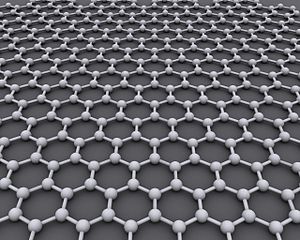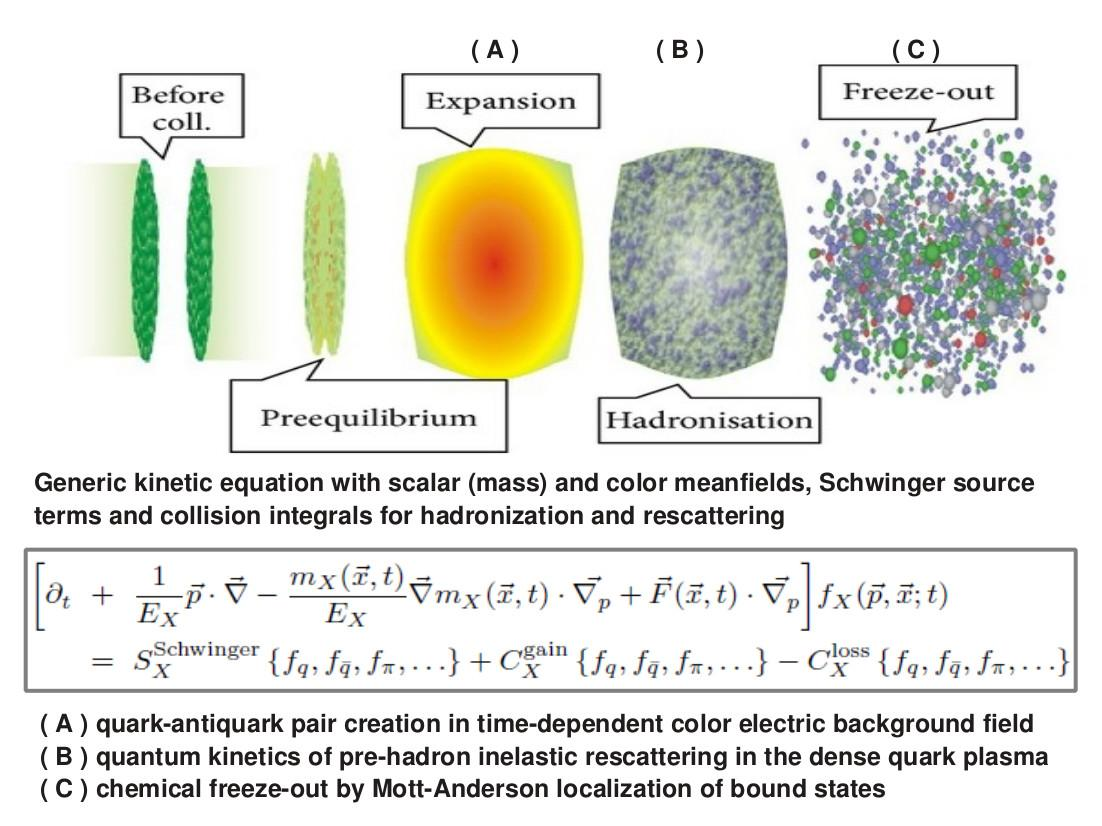Quantum kinetics of particle production in strong fields

Overview
[More details on project objectives, methodology and impact of the project ... ]
This project was devoted to investigations that should deepen our understanding of the fundamental principles governing the phenomenon of particle creation in strong fields. The results of these studies were directly applied in three domains of modern physics:- A) Laser colliders, where the dynamical Schwinger effect of creating electron-positron pairs from the vacuum can be tested. For the development of the laser technologies that will make such experiments possible in the future the Nobel prize in Physics 2018 was awarded;
- B) Graphene (Nobel prize 2010), the material which allows tests of chiral field theories that apply for (approximately) massless fermions, like quarks, which gain their mass from dynamical symmetry breaking (Nobel prize 2008), similar to the Higgs mechanism (Nobel prize 2013). Here the creation of electron-hole pairs (and their correlations - excitons) by application of a strong electric field was studied;
- C) Relativistic heavy-ion collisions, where quarks and gluons are produced in strong, time-dependent color-electric fields (flux-tubes) and, after their bound state formation (hadronization) show generally a thermal distribution as well as a chemical composition astonishingly well described by a simple statistical model, except the lightest hadrons, the pions, which indicate the onset of Bose-Einstein condensation (Nobel prize 2001).



The common theme of the studies in these diverse directions is the kinetic equation approach with a Schwinger-type source term for particle production in strong, time-dependent external fields. For the rather complex and challenging situation in heavy-ion collisions, after the parton (quarks and gluons) production stage which is described by this dynamical Schwinger effect, elastic scattering processes leading to thermalization and the conversion of partons to hadrons by a schematic hadronization process is studied. The highlight of this innovative, exploratory calculation is a direct relation between the overpopulation of gluonic phase space and the low-momentum enhancement of the pion distribution as a precursor of Bose-Einstein condensation. While this effect, observed by the ALICE experiment at CERN-LHC, has been attributed to Bose-Einstein condensation of pions and their non-equilibrium distribution function before, the elucidation of the nonequilibrium kinetic process behind this effect was so far missing. Another pioneering result of the studies was a contribution to the understanding of sudden chemical freeze-out due to the localization of the (multi-) quark wave function into a hadronic one when traversing the phase border in the QCD phase diagram, analogously to the Mott-Anderson localization effect (Nobel prize 1977), when the color (super)conducting state of the quark-gluon plasma transforms into a color-insulating hadron gas.
We made important contributions to popularization of these fundamental science topics and our results as well as to educating the young generation of scientists, by organizing a Winter College on “Nonlinear Optics, Attosecond Science and High-Field Physics” at the ICTP Trieste, Italy (February 5-17, 2018) and a Helmholtz International Summer School on “Quantum Field Theories at the Limits: From Strong Fields to Heavy Quarks”, JINR Dubna, Russia (July 18-30, 2016).
One PhD Thesis was completed (E. Nazarova, 12/2018) and two are in the final stage (L. Juchnowski & M. Naskret).
The results are published (or submitted to publication) in 13 journal articles, 9 Proceedings contributions and 1 Book chapter.
Publications in refereed journals
Dynamical Schwinger effect: Properties of the e+ e- plasma created from vacuum in strong laser fields
By D. Blaschke, L. Juchnowski, A. Panferov, S. Smolyansky,
Phys. Part. Nucl. 46 (2015) no.5, 797-800
Pair production by Schwinger and Breit–Wheeler processes in bi-frequent fields
By A. Otto, T. Nousch , D. Seipt , B. Kämpfer, D. Blaschke, A.D. Panferov, S.A. Smolyansky, A.I. Titov,
J. Plasma Phys. 82 (2016) no.3, 655820301
Assisted dynamical Schwinger effect: pair production in a pulsed bifrequent field
By A. D. Panferov, S. A. Smolyansky, A. Otto, B. Kämpfer, D. B. Blaschke,
L. Juchnowski,
Eur. Phys. J. D70 (2016) no.3, 56
Neutrino emissivities and bulk viscosity in neutral two-flavor quark matter
By J. Berdermann, D. Blaschke, T. Fischer, A. Kachanovich,
Phys. Rev. D94 (2016) no.12, 123010
Vacuum particle-antiparticle creation in strong fields as a field induced phase transition
By S.A. Smolyansky, A.D. Panferov, D.B. Blaschke, L. Juchnowski, B. Kämpfer, A. Otto,
Russ. Phys. J. 59 (2017) no.11, 1731-1738
NA61/SHINE Experiment—Program beyond 2020
By Ludwik Turko,
Particles 2018, 1(1), 296-304
[arXiv:1811.05522 [nucl-ex]]]
Looking for the Phase Transition—Recent NA61/SHINE Results
By Ludwik Turko,
Universe 4 (2018) no.3, 52
Measurements of 𝜋±, 𝐾± and proton yields from the surface of the T2K replica target for incoming 31 GeV/c protons with the NA61/SHINE spectrometer at the CERN SPS
By N. Abgrall et al. (including M. Naskret and L. Turko),
Eur.Phys.J. C79 (2019) no.2, 100
Thermodynamics of a generalized graphene-motivated (2+1) - dimensional Gross-Neveu model beyond mean field within the Beth-Uhlenbeck approach
By D. Ebert, D. Blaschke,
PTEP 2019 123 [pdf]
Universal chemical freeze-out of hadrons in heavy-ion collisions
By D. Blaschke, J. Jankowski, M. Naskret,
(Submitted to Eur. Phys. J. C)
Nonperturbative kinetic description of electron-hole excitations in graphene in a
time dependent electric field of arbitrary
polarization
By S. A. Smolyansky,
A. D. Panferov,
D. B. Blaschke, N. T. Gevorgyan,
Particles 2 (2019) no.2, 208-230 [pdf]
Low-momentum pion enhancement from
schematic hadronization of a gluon-saturated
initial state
By E. N. Nazarova, L. Juchnowski,
D. B. Blaschke, T. Fischer,
Particles 2 (2019) no.1, 140-149 [pdf]
Kinetic approach to pair production in strong
fields - Two lessons for applications to
heavy-ion collisions
By D. B. Blaschke, L. Juchnowski, A. Otto,
Particles 2 (2019) no.2, 166-179 [pdf]
Chapters in books
Laser assisted Breit-Wheeler and Schwinger processes
By T. Nousch, A. Otto, D. Seipt, B.
Kaempfer, A.I. Titov, D.
Blaschke, A.D. Panferov, S.A.
Smolyansky,
New Horizons in Fundamental Physics, FIAS Interdisciplinary Science Series
Proceedings
Nonequilibrium meson production in strong fields
By L. Juchnowski, D. Blaschke, T.
Fischer, S. A. Smolyansky,
J. Phys. Conf. Ser. 673 (2016) no.1, 012009
Schwinger effect at modern laser facilities
By D. Blaschke, N. T. Gevorgyan, A. D. Panferov, S. A. Smolyansky,
J. Phys.: Conf. Ser. 672, 012020
Field induced phase transition in the few photon regime
By A. D. Panferov, S. A.
Smolyansky, A. I. Titov, B.
Kaempfer, A. Otto, D. B.
Blaschke, L. Juchnowski,
EPJ Web Conf. 138 (2017) 07004
Generalized Beth-Uhlenbeck approach to the equation of state for quark-hadron matter
By D. Blaschke, A. Dubinin, L. Turko,
Acta Phys.Polon.Supp. 10 (2017) 473-480
Particle Production in Strong Time-dependent Fields
By D. B. Blaschke, S. A. Smolyansky, A. Panferov, L. Juchnowski,
DESY-PROC-2016-04
Comparing two different descriptions of the
I-V characteristic of graphene: theory and
experiment
By A. Panferov, S. Smolyansky, D Blaschke, N. Gevorgyan,
EPJ Web Conf. 204 (2019) 06008 [pdf]
Possible signals of two QCD phase transitions at NICA-FAIR energies
By A. K. A. Bugaev et al. (including D. B. Blaschke),
EPJ Web Conf. 204 (2019) 03001 [pdf]
On separate chemical freeze-outs of hadrons and light (anti)nuclei in high energy nuclear collisions
By A. K. A. Bugaev et al. (including D. B. Blaschke),
J.Phys.Conf.Ser. 1390 (2019) no.1, 012038 [pdf]
Public outreach
Organized conferences
Quantum Field Theory at the Limits: from Strong Fields to Heavy Quarks,
Dubna, 18 - 30 July 2016
Colloquium on Nonequilibrium phenomena in strongly correlated systems,
Dubna, 18 - 19 April 2018
Some talks
Nonequilibrium pion distribution in heavy-ion collisions from the Zubarev approach
by David Blaschke
Colloquium on Nonequilibrium phenomena in strongly correlated systems,
Dubna, 18 - 19 April 2018
Particle Production in Strong Time-dependent Fields
by David Blaschke
Winter College on Extreme Non-linear Optics, Attosecond Science and High-field Physics,
Trieste, Italy, 5 - 15 February 2018
Kinetic equation approach to particle production - from laser to heavy-ion colliders
by David Blaschke
LPHYS' 18, Nottingham, July 16-20, 2018
Relaxation rates and phase transitions by Jakub Jankowski ZIMÁNYI SCHOOL'16 5-9 December 2016, Wigner Research Center for Physics, Budapest, Hungary
Dynamics, phase transitions and holography [pdf] [mp3] by Jakub Jankowski Recent Trends in String Theory and Related Topics 8-11 May 2017 (18-21 Ordibehesht 96) IPM, Tehran, Iran
NA61/SHINE program beyond 2020
by Ludwik Turko
II International Workshop on Simulations of HIC for NICA energies
and Colloquium on Nonequilibrium phenomena in strongly correlated systems
16-19 April 2018 Dubna, Russia
Nonequilibrium meson production in strong fields
by Łukasz Juchnowski,
II International Workshop on Simulations of HIC for NICA energies
and Colloquium on Nonequilibrium phenomena in strongly correlated systems
16-19 April 2018 Dubna, Russia